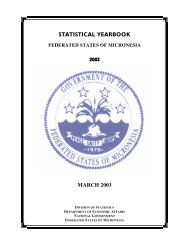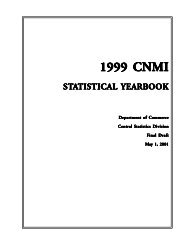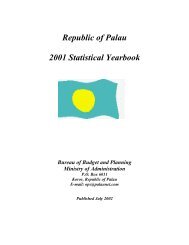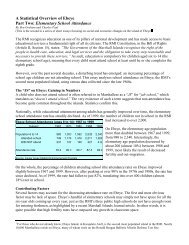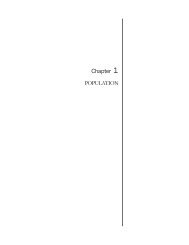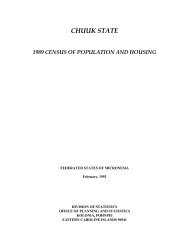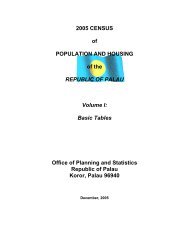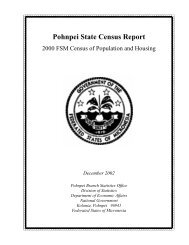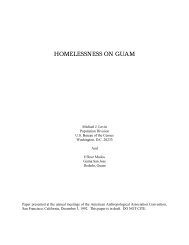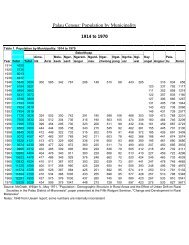Chuuk State Census Report - pacificweb.org
Chuuk State Census Report - pacificweb.org
Chuuk State Census Report - pacificweb.org
You also want an ePaper? Increase the reach of your titles
YUMPU automatically turns print PDFs into web optimized ePapers that Google loves.
CHAPTER 11INCOMEIntroductionThe 2000 FSM <strong>Census</strong> asked for cash income earned in 1999 from all persons 15 years and older. Income provides ameasure of how well cash resources are distributed within the country as well as an insight into the sources of cash in<strong>Chuuk</strong>. Cash income is the amount of money received during a fixed period of time. For the 2000 FSM <strong>Census</strong>, thetime period referred to be calendar year 1999. Income includes wages or salaries, cash income from farm or non-farmbusinesses, interest and dividends or net rentals, estates or trusts, social security or retirement, and remittances.The census collected income for households, families and by individual. Household income included all cash incomeearned by each member living in a housing unit who was aged 15 years and over. Family income included the cashincome from those members of a household with two or more related members. Individual income is based on what anindividual earned during 1999. Household and family income did not include those people enumerated in groupquarters on census day. However, individual income did include those people in group quarters.About 60 percent of the population aged 15 years and over reported receiving cash income in 1999. The person with a19,090 income was a small portion of the 31,587 persons in the working age population. The only persons used in themeasures of income were those who reported an income for 1999. Thus measures of income were considered only forthose persons who received money through salaries, wages, social security or other sources. Fully 68 percent of thepopulation 15 years and over reported no income.DefinitionsWage or salary income is the total amount of money earned by a person working as an employee for a privateenterprise (business or farm) or a branch of government. Wage or salary income includes take-home pay plus alldeductions for withholding tax, social security, union dues, bonds, uniforms, and others. Also included are piece-ratepayments, commissions, tips, bonuses, and sick leave pay. Own business income includes money receipts as well asbusiness expenses. Interests and dividends are money earned from savings or shares. Social security and governmentbenefits include payments from retirement, or disability payments. Remittances include money received from relativeswithin and outside of the FSM who are not living with the individual.Two statistics were used to analyze income: median and mean. The median income is that income value that dividesincome recipients into two equal halves. The mean income is the sum of all income in a region or characteristicdivided by the number of income recipients. (Similarly, the aggregate of all incomes in a region can be found bymultiplying the mean by the number of persons earning income.) The median is a better estimate of average incomebecause it places less emphasis on extreme values and is less susceptible to the effects of misreporting and processingerrors. In this chapter both median and mean are used in most tables.Limitations and Comparability. Income is a self-reported number and is easily misreported due to income inflation ordeflation or to poor recollection. In the case of the FSM 1994 <strong>Census</strong>, the income was received at least 9 months priorto the time of reporting, making it easier to f<strong>org</strong>et small or irregular income. Other errors occurred because ofmisunderstandings such as reporting net rather than gross earnings. The 1980 TTPI census collected similarinformation on income and these data are used here with an inflation factor to compare against the 2000 <strong>Census</strong> data.Furthermore, the data collected during 1980, 1994 and 2000 <strong>Census</strong>es refer to cash income only.Income data may not fully explain the economy in <strong>Chuuk</strong> because of the significant share of subsistence activities inthe economy. It does, however, give an indication of <strong>Chuuk</strong> population’s access to material possessions and changes inthe cash economy.<strong>Chuuk</strong> Branch Statistics Office, Division of Statistics, FSM Department of Economic Affairs 101



